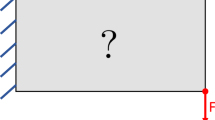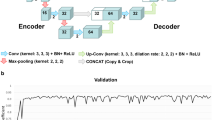Abstract
Constructing 3D surfaces that interpolate 2D curves defined on parallel planes is a fundamental problem in computer graphics with wide applications including modeling anatomical structures. Typically the problem is simplified so that the 2D curves partition each plane into only two materials (e.g., air versus tissue). Here we consider the general problem where each plane is partitioned by a curve network into multiple materials (e.g., air, cortex, cerebellum, etc.). We present a novel method that automatically constructs a surface network from curve networks with arbitrary topology and partitions an arbitrary number of materials. The surface network exactly interpolates the curve network on each plane and is guaranteed to be free of gaps or self-intersections. In addition, our method provides a flexible framework for user interaction so that the surface topology can be modified conveniently when necessary. As an application, we applied the method to build a high-resolution 3D model of the mouse brain from 2D anatomical boundaries defined on 350 tissue sections. The surface network accurately models the partitioning of the brain into 17 abutting anatomical regions with complex topology.
Similar content being viewed by others
References
Aichholzer, O., Aurenhammer, F.: Straight skeletons for general polygonal figures in the plane. In: Computing and Combinatorics, pp. 117–126 (1996). http://citeseer.ist.psu.edu/aichholzer96straight.html
Bajaj, C.L., Coyle, E.J., Lin, K.N.: Arbitrary topology shape reconstruction from planar cross sections. Graph. Models Image Process. 58(6), 524–543 (1996). DOI http://dx.doi.org/10.1006/gmip.1996.0044
Barequet, G., Goodrich, M.T., Levi-Steiner, A., Steiner, D.: Straight-skeleton based contour interpolation. Graph. Models 65, 323–350 (2004)
Barequet, G., Sharir, M.: Piecewise-linear interpolation between polygonal slices. Comput. Vis. Image Understand. 63, 251–272 (1996)
Bloor, M., Wilson, M.: Local control of surfaces generated using partial differential equations. Comput. Graph. 18(3), 161–169 (1994)
Boissonnat, J.D.: Shape reconstruction from planar cross sections. Comput. Vis. Graph. Image Process. 44(1), 1–29 (1988)
Chai, J., Miyoshi, T., Nakamae, E.: Contour interpolation and surface reconstruction of smooth terrain models. In: VIS ’98: Proceedings of the Conference on Visualization, pp. 27–33. IEEE Press, New York (1998)
Cheng, S.W., Dey, T.K.: Improved constructions of delaunay based contour surfaces. In: SMA ’99: Proceedings of the 5th ACM Symposium on Solid Modeling and Applications, pp. 322–323. ACM Press, New York (1999). DOI http://doi.acm.org/10.1145/304012.304061
Christiansen, H.N., Sederberg, T.W.: Conversion of complex contour line definitions into polygonal element mosaics. Comput. Graph. 13, 187–192 (1978)
Csébfalvi, B., Neumann, L., Kanitsar, A., Gröller, E.: Smooth shape-based interpolation using the conjugate gradient method. In: Proceedings of Vision, Modeling, and Visualization, pp. 123–130 (2002)
Foley, J.D., van Dam, A., Feiner, S.K., Hughes, J.F.: Computer Graphics (2nd edn). Addison-Wesley, Reading, MA (1990)
Fuchs, H., Kedem, Z.M., Uselton, S.P.: Optimal surface reconstruction from planar contours. Commun. ACM 20(10), 693–702 (1977). DOI http://doi.acm.org/10.1145/359842.359846
Geiger, B.: Three-dimensional modeling of human organs and its application to diagnosis and surgical planning. Technical report RR-2105. http://citeseer.ist.psu.edu/geiger93threedimensional.html
Hagen, H.: Focus on Scientific Visualization. Springer, Berlin Heidelberg New York (1993)
Herman, G.T., Zheng, J., Bucholtz, C.A.: Shape-based interpolation. IEEE Comput. Graph. Appl. 12(3), 69–79 (1992). http://dx.doi.org/10.1109/38.135915
Ju, T.: Robust repair of polygonal models. ACM Trans. Graph. 23(3), 888–895 (2004). http://doi.acm.org/10.1145/1015706.1015815
Ju, T., Losasso, F., Schaefer, S., Warren, J.: Dual contouring of hermite data. In: SIGGRAPH ’02: Proceedings of the 29th Annual Conference on Computer Graphics and Interactive Techniques, pp. 339–346. ACM Press, New York (2002). http://doi.acm.org/10.1145/566570.566586
Ju, T., Warren, J., Eichele, G., Thaller, C., Chiu, W., Carson, J.: A geometric database for gene expression data. In: Proceedings of the Eurographics/ACM SIGGRAPH Symposium on Geometry Processing, pp. 166–176 (2003)
Keppel, E.: Approximating complex surfaces by triangulation of contour lines. IBM J. Res. Develop. XIX, 2–11 (1975)
Klein, R., Schilling, A., Straßer, W.: Reconstruction and simplification of surfaces from contours. Graph. Models 62(6), 429–443 (2000). http://citeseer.ist.psu.edu/klein00reconstruction.html
Meyers, D., Skinner, S., Sloan, K.: Surfaces from contours. ACM Trans. Graph. 11(3), 228–258 (1992). http://doi.acm.org/10.1145/130881.131213
Moody, D., Lozanoff, S.: Surfdriver: A practical computer program for generating three-dimensional models of anatomical structures
Oliva, J.M., Perrin, M., Coquillart, S.: 3d reconstruction of complex polyhedral shapes from contours using a simplified generalized voronoi diagram. Comput. Graph. Forum 15(3), 397–408 (1996)
Sloan, K.R., Painter, J.: From contours to surfaces: testbed and initial results. In: CHI ’87: Proceedings of the SIGCHI/GI Conference on Human Factors in Computing Systems and Graphics Interface, pp. 115–120. ACM Press, New York (1987). http://doi.acm.org/10.1145/29933.30869
Turk, G., O’Brien, J.F.: Shape transformation using variational implicit functions. In: SIGGRAPH ’99: Proceedings of the 26th Annual Conference on Computer Graphics and Interactive Techniques, pp. 335–342. ACM Press/Addison-Wesley New York (1999). http://doi.acm.org/10.1145/311535.311580
Weinstein, D.: Scanline surfacing: Building separating surfaces from planar contours. In: Visualization ’00: Proceedings of the 11th IEEE Visualization 2000 Conference. IEEE Press, New York (2000)
Wolfram, S.: The Mathematica Book. Wolfram Media/Cambridge University Press, Cambridge, UK (1993)
Author information
Authors and Affiliations
Corresponding author
Rights and permissions
About this article
Cite this article
Ju, T., Warren, J., Carson, J. et al. Building 3D surface networks from 2D curve networks with application to anatomical modeling. Visual Comput 21, 764–773 (2005). https://doi.org/10.1007/s00371-005-0321-3
Published:
Issue Date:
DOI: https://doi.org/10.1007/s00371-005-0321-3




